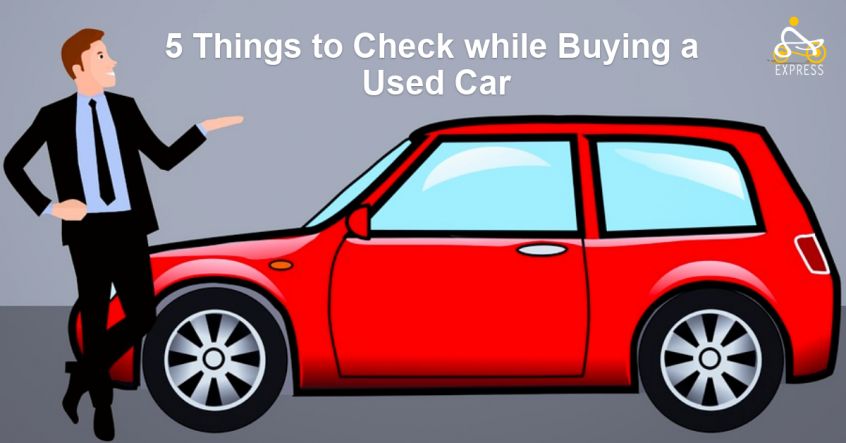The market for second-hand vehicles in India is huge. To such an extent, that a Frost and Sullivan report from a year ago pegs second-hand vehicle buy number to be as high as being equivalent to new vehicle deals in the year! Utilised vehicle or not – first vehicle is a truly major ordeal.
1. Get the vehicle and its papers assessed completely
- Get the second-hand vehicle examined entirely by an expert you trust. This serves to either get the issues fixed by the proprietor before the buy is done or encourages you to arrange the cost. A couple of must DOs for this:
- Check the current protection papers of the second-hand vehicle you are going to purchase. You will most likely show if the vehicle has had any mishaps or cases identified with those. A quick method to see this on the approach is to take note of the no matter reward (NCB) rate connected. The higher the NCB, the better.
- Check if the engine number and frame no. Coordinate the number in the enlistment papers before you purchase the second-hand vehicle.
- Check every one of the channels of the second-hand vehicle, and get them changed if conceivable. All channels (air, fuel, transmission, oil) need standard cleaning and oiling. Neglecting to do this can influence the execution of the vehicle fundamentally. In the case of nothing else, this is a fast judge of how well the vehicle has been kept up.
- Check the brakes of the second-hand vehicle. Drive the vehicle at 40-50 kmph in a region that has practically zero traffic. Make sure to search for any vibration or any unusual and screeching commotion from the brake pedal. Brakes that throb could likewise imply that the rotors need substitution.
- Look at the tires cautiously. Check the state of the considerable number of feels burnt out on your vehicle. They ought to be worn equally and should coordinate.
- Check in the engine for indications of harm, gouges or rust – they are indications of an inadequately kept up vehicle or an earlier harmed one.
2. Exchange the Registration Certificate (RC) of the second-hand vehicle in your name
- Get the second-hand vehicle examined entirely by an expert you trust. This serves to either get the issues fixed by the proprietor before the buy is done or encourages you to arrange the cost. A couple of must DOs for this:
- For this, you should round out and submit Form 29 and Form 30, issued by the RTO in the ward you live in (Find the RTO nearest to your habitation here). The structure ought to be marked by both the past proprietor and you. On the off chance that the vehicle is enlisted in an alternate purview from yours, at that point, a NOC from that locale’s RTO will help speed the procedure. This registers the exchange.
- After accommodation, the neighbourhood RTO starts the exchange. You will get a receipt inside 15-18 days and the name-changed RC duplicate by the 40th-45th day. In the meantime, photocopies of these structures or the receipt fill in as verification of exchange.
- When the RC is exchanged, there are likewise a couple of other significant things to deal with: Most notably, getting the second-hand vehicle protection strategy moved in your name, or purchasing another one out and out. (Subtleties in the following segment)
- Check structure 32 and 35 to guarantee that there are no prior pending credits on the second-hand vehicle you are purchasing.
- On the off chance that was purchasing a second-hand vehicle purchased by the past proprietor on the fund, guarantee that you get the first receipt of the vehicle. Additionally, get the No Objection Certificate (NOC) from the vehicle fund organisation.
- Administration book to check the historical backdrop of administration records Road charge receipts with the last refreshed instalment before you purchase a second-hand vehicle
- Bi-fuel accreditation if the vehicle is CNG/LPG fitted.
- Substantial Pollution Under Control (PUC) declaration
3. Get your work done
It’s as imperative to have a legitimate protection arrangement duplicate in your name all things considered to get the enlistment exchanged. If the RC is enrolled in your name and the approach is still under the past owner’s, at that point, the protection arrangement stands invalidated! Along these lines, it’s imperative to move the protection in your name in the wake of purchasing the second-hand vehicle.
There can be three potential approaches to get the second-hand vehicle protection in your name
- A name change in the past proprietor’s strategy
- On the off chance that you need to exchange the second-hand vehicle protection, it must be a procedure parallel to the exchange of possession. Numerous second-hand vehicle dealers, just as purchasers, are uninformed of this crucial point and accept that the past proprietor’s arrangement is substantial.
- The photocopy of the receipts/structure 29/30 can be utilised to apply for the name exchange on the second-hand vehicle’s protection strategy. Concerning the procedure, you need to contact the insurance agency, a specialist of the organisation or a merchant like us who can assist you with the process.
4. Exchange of No Claim Bonus (NCB)
NCB is given to the protected and not the guaranteed vehicle. Thus, on an exchange of the vehicle, the protection arrangement can be exchanged to the new proprietor however not the NCB. The new proprietor needs to pay the distinction because of the NCB for the equalisation approach period. The first proprietor can notwithstanding, utilise the NCB on another vehicle obtained by him.
Fundamentally this means two things:
- In case you’re exchanging the arrangement from the past proprietor, and he has an NCB rebate on the strategy, this can’t be transferred to you. On the off chance that you’ve had a vehicle before, and a no case reward rebate is pertinent, the last insurance agency you held the strategy with, ought to have issued an NCB saving letter to you, which is legitimate for a long time from the season of the last approach expiry.
- You can utilise this letter and apply this rebate to the new strategy you purchase, or modify the master appraised sum if there should arise an occurrence of exchanging the past proprietor’s arrangement in your name. Do take note of that if your NCB sum is more noteworthy than your dealers’, you won’t get a discount.
So even from the NCB perspective, it is best that you purchase another arrangement once again, in your name.
5. Clean and fix your vehicle before the principal drive
“On the off chance that you need to purchase a vehicle from a seller, ensure it’s a built up one. With any future issues, you’ll have an excellent opportunity to have your vehicle fixed at a built up business. You will realise that the vehicle hasn’t been stolen and that you’ll have a forward-thinking administration history. I wouldn’t purchase a vehicle from loved ones; however, if you do, ensure the vehicle has been very much kept up throughout the years.”
Here’s a couple of things you should deal with:
- A careful tidy up: Both inside and outside. (Another vehicle’s right, be it new or old, is to look sparkly if you need to display it!). On the off chance that conceivable, consider steam cleaning and purifying your new vehicle.
- Change of liquids: Life anticipation of a vehicle dependably relies upon how well you keep up it and a customary difference in fluids and oils is an absolute necessity! The best activity after purchasing a second-hand vehicle is to change every one of the liquids immediately before utilising it.
- Convenient solutions to be done: that is Fixing of lights, sparkle plugs and so forth. Any indication of rust, water section through splits and gaps or other wear of the storage compartment ought to likewise be checked and fixed. Everything arranged? Presently you’re good to go to dive in! Appreciate the rush of riding your very own well deserved, merited vehicle!
Expectation the above trade-in vehicle purchasing guide has given you a decent knowledge of purchasing utilised autos. We would love to hear your understanding and learnings, if you’ve purchased a trade-in vehicle, or offer your inquiries with us, in case you’re thinking about buying a trade-in vehicle.



